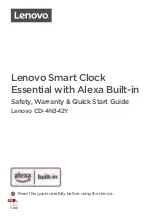
SA.45s Chip-Scale Atomic Clock
SA.45s CSAC User Guide Revision D
37
Figure 19 • CSAC Disciplined to a Superior Reference
In the previous graph, when disciplining was enabled, at T = 10 seconds after the event of enabling
disciplining, the steering algorithm immediately inserted a frequency offset of –9 × 10 , to steer out the
–9
50 ns phase error with 20 second time constant. The steering gradually reduces as the phase
approaches zero such that both frequency and phase are corrected to within 1/e of their initial values at
one time constant (20 s) and 1/e within two time constants (40 s). After five-six time constants (≈ 100 s)
2
frequency and phase are corrected to within ±5 × 10 and ±5 ns, respectively.
–13
3.7.2
Heat Sink
The CSAC does not require a heat sink because it consumes low power and therefore produces little
heat. Furthermore, the external parts of CSAC are mu-metal (80% nickel), which is a poor thermal
conductor (1/5 that of aluminum). There is no useful thermal path from the inside components to the
baseplate or the cover.
3.7.3
Notes on Soldering
For initial testing and evaluation, it is recommended that the pins must not be modified or soldered to a
PCB. The recommended socket for PCB attachment is Tyco P/N 4-5332070-4.
After evaluation, the pins can be hand soldered to a PCB using 63/37 tin/lead solder with a maximum
soldering tip temperature of 329 °C (625 °F).
Hand soldering is a necessary requirement for CSAC, and solder re-flow is not recommended because
the CSAC cannot go above storage temperature (it is likely to damage it).
The lead material is 52 Alloy with a plating of 50 µin gold minimum (ASTM 8488-01) over 100 µin nickel
(QQ-N-290).
3.7.4
Notes on the Evaluation Board
The following illustration shows the reference schematic for the evaluation board.





































